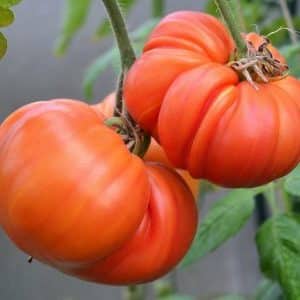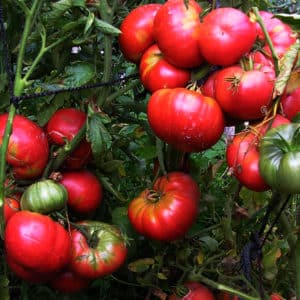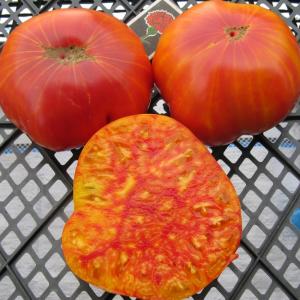Advantages and disadvantages of the Mammoth tomato
The variety of tomato varieties is amazing. Every season, gardeners face a choice: use old proven crops or try new breeding achievements. The Mammoth variety was developed more than ten years ago. It has successfully passed tests in different regions of Russia. The variety has not gained much popularity, but it has loyal fans.
Let's look at the advantages and disadvantages of the Mammoth variety and find out whether it is worth growing.
Characteristics and description of the variety
Before growing a new variety, you need to know its main characteristics. This will save you from annoying mistakes during breeding.
The main feature of the Mammoth variety is indicated by its name. It is famous for its large fruits weighing from 300 to 500 g. The tomatoes are sweet, pink and raspberry in color. But there are also unevenly colored tomatoes, the so-called “marbled”.
The fruits are semicircular, flattened, fleshy and starchy. There are few seeds in them and they are small. The cut may have white veins.
Ripe tomatoes are soft and distinctly ribbed. Due to their size they may crack.
The variety is early ripening, which is not typical for such large fruits. Used for food and for preparing fresh vegetable salads. Not suitable for preservation due to its size.
Bush characteristics:
- The bushes grow up to 2 m. To bring the shoot to such a height, it is necessary to grow them into two trunks.
- The leaves are dark green, medium to small in size. There are few of them, and the giant fruits on the bush are clearly visible.
- 4-5 clusters are formed on the bushes, 3-4 tomatoes are tied on each. The normal yield from one bush is 20 fruits. But what kind! The weight of the harvest from one bush can be about 10 kg.
- The average time from sowing to fruit ripening is 110-115 days. Can be grown both in a greenhouse and in open ground.
Variety Black Mammoth
There is a variety similar in characteristics - Black Mammoth. Belongs to the mid-season, medium-sized species. The fruits are fleshy, dense, and have a dark burgundy color when ripe. The weight of the fruit varies from 200 to 500 g. Large berries may crack.
The Black mammoth variety bush is formed into two or three stems. But to get giant fruits, farmers leave one stem. It is not recommended to use tomatoes for preparations or to preserve them in slices. Preferred use is fresh consumption in salads, making juices.
The rules of agricultural technology for growing the Black Mammoth variety are the same as for the Mammoth variety.
Pros and cons of the variety
Advantages of the Mammoth variety:
- high yield throughout the season;
- large sweet fruits;
- precocity and early ripening;
- suitable for cultivation in any region;
- unpretentiousness - drought and heat resistance;
- resistance to diseases and pests.
Minuses:
- requires care - tying up bushes, tearing off excess inflorescences;
- cracking of the largest tomatoes;
- not suitable for canning and long-term storage.
As you can see, the advantages of the variety outweigh its disadvantages. Deficiencies can be easily corrected if you pay attention to them in time, harvest in a timely manner and use the fruits correctly.
How to grow
We bring to your attention instructions for growing crops from planting seedlings to harvesting.
Seedling period
To ensure that all the seeds germinate and the seedlings do not die, follow the basic rules.
Mammoth should be sown in late February - early March. At first, it is better to germinate the seeds in a common box with soil. To do this, the seed is pre-soaked in the solution. potassium permanganate or as a growth stimulant. Both can be purchased at garden and flower shops.
Then the treated seed material is planted in the soil to a depth of 2 cm. The container is covered with film or glass and placed in a warm place until the first shoots. The soil does not require watering, but it is better to lightly moisten it with a spray bottle to prevent drying out. After the sprouts appear, the seedlings are placed in a well-lit place.
After the first true leaves appear, the seedlings need to be planted in separate cups. Peat ones are perfect.
The seedlings are watered as the soil dries. Organic and inorganic fertilizers are applied 2-3 times.
Important! For subsequent acclimatization, seedlings need to be hardened off.
A couple of weeks before planting in the ground, the seedlings are taken outside. Hardening begins with 20-30 minutes, gradually increasing the time to several hours a day. This is how tomatoes get used to open air and temperature changes. If you plan to grow tomatoes in a greenhouse, hardening is not necessary.
Planting and fruiting
Breeders who developed the variety draw the attention of farmers to the fact that To obtain large Mammoth fruits and high yields, the following measures must be taken:
- prepare strong, healthy seedlings;
- plant it in the ground for 50-55 days;
- maintain the distance between bushes;
- be sure to carry out timely stepsoning;
- monitor the number of brushes and inflorescences;
- Regularly fertilize and feed tomatoes.
The seedlings are placed in the garden at the rate of three bushes per square meter. Add one tablespoon of fertilizer to each tomato hole. Usually it is a mixture of superphosphate and potassium sulfate.
Reference! Seedlings are planted in open ground at a distance of 50 cm. This way the plants will not interfere with each other and will take the nutrients they need from the soil.
The Mammoth variety does not need abundant watering and is even harmful. Excess moisture leads to cracking of the largest fruits. It is enough to water once a week.
Before watering, it is recommended to loosen the soil and remove weeds.
Carefully observe the appearance of the tomatoes. On weak bushes, ovaries will not form. This variety needs feeding constantly.
Organic fertilizers are considered the most effective and harmless: manure, humus, chicken droppings, compost. They are diluted with water and watered the bushes. However, remember that high concentrations of fertilizers can burn the plant.
Productivity and fruit size directly depend on the correct formation of bushes. Monitor the number of inflorescences and leave three to four flowers on each brush.
Attention! After the inflorescences appear from the bushes, it is necessary to periodically remove dry and dying lower leaves.
During the formation of fruits, for their growth and rapid ripening, experts recommend using fertilizing with magnesium sulfate.
Magnesium accelerates plant growth and increases yield. It improves the taste of the fruit and its usefulness for the human body. Magnesium is harmless to plants and is part of chlorophyll.
Sulfur deficiency is visible by changes in leaf color. From dark green they become pale.If this sign is noticed, the bushes need to be fed.
Nitrogen, potassium and phosphorus are also used as fertilizers. Mammoth tomatoes need to be fertilized every two weeks. It is important to monitor the composition of fertilizers: there should be less nitrogen than phosphorus and potassium.
Prevention of diseases and pests
The Mammoth variety is resistant to diseases, but it is better to carry out prevention at all stages of cultivation.
Let's look at the main diseases of tomatoes.
In first place in terms of prevalence are fungi. They attack the plant inside and out. They parasitize stems and leaves and reproduce by spores.
Main fungal diseases:
- late blight;
- blackleg;
- white leaf spot;
- fusarium wilt;
- different types rotten (black, gray, white).
Methods for treating tomatoes against fungus:
- spraying seedlings with copper oxychloride;
- timely removal of dead leaves;
- fertilizing the soil with trichodermin a week before the intended planting.
The risk of seedlings becoming infected with fungal diseases can be reduced by paying attention to the soil. It is necessary to disinfect open ground and choose high-quality soil for seedlings (preferably in a store from a trusted manufacturer).
Another group of diseases is viral.
Causes:
- infected seeds;
- disease-carrying insects;
- contaminated soil.
Fighting viruses is more difficult; their occurrence is easier to prevent in the following ways:
- changing places for planting seedlings;
- processing of greenhouses and containers for seedlings;
- insect control;
- weed control.
Bacterial diseases - black bacterial spot, brown leaf spot, stolbur and others.
Ways to fight:
- use of high-quality antibiotics;
- buying quality seeds.
In addition to the listed diseases, tomatoes have other problems. They are associated with a deficiency of minerals in the soil and violation of planting technologies.
Reviews from gardeners
Farmers who have already grown this variety are generally satisfied with the results. Here are a few reviews.
Irina, Tambov: «Incredibly large fruits, as in the photo from the seed packaging, and high yield of the variety. A few bushes are enough for a large family to eat sweet tomatoes all summer. Grown in a greenhouse. I will plant next year too.”
Valentina, Penza: “The tomatoes grew the way I like best - fleshy, without excess juice and with invisible seeds. Ideal for salads and main courses. They taste sweet, you can eat them like a village, just with bread and salt.”
Vyacheslav Ivanovich, Orel: “I wouldn’t say it’s an early variety. More like mid-early. But there may be a dependence on the region. Maybe my conditions were not suitable for this variety. The fruits are large, but not gigantic, unlike those stated. They taste sweet. Color ranges from pink to deep crimson. I used seeds from Aelita-Agro.
Conclusion
Mammoth tomatoes are large and high-yielding varieties and produce tasty, healthy, vitamin-rich fruits. The variety is suitable for different climatic conditions, cultivated in the ground and in greenhouse structures.
However, high productivity is achievable only with appropriate care. Among the disadvantages of the culture is the short storage of ripe fruits. In addition, Mammoth is not suitable for whole-fruit canning. Nevertheless, experienced gardeners value this variety for its taste and use it in preparing salads and other dishes.